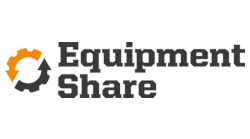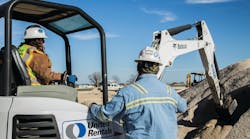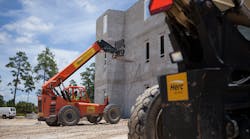RER talks with Mircea “Mig” Dobre, CRA, senior research analyst – machinery & diversified industrial, Robert W. Baird & Co., about the U.S. economy, inflation, supply chain and areas of strength in the U.S. construction economy in the coming years.
RER: Starting off, how about a basic overview of how you see the economy in the coming year, in terms of inflation, interest rates, fuel prices and so on and how those concerns might affect the construction and rental economies?
Dobre: I think the outlook here is for a slowdown. That’s a direct effect of what you’re seeing in interest rates markets, what the Federal Reserve actions are trying to accomplish with three unprecedented interest rate hikes, unlike anything we’ve seen in the past four decades. But the good news is that inflation is indeed starting to break and we’re seeing this pretty broadly, not just in consumer prices, but in producer prices. And we’re seeing it in input costs. We’re more importantly seeing it in construction materials, and I think that’s especially relevant for your readers.
As far as rental markets are concerned, there’s a very similar dynamic. My expectation is for slower growth going forward and that’s pretty consistent with what ARA is forecasting as well.
I think that outlook is pretty spot on and depending on how the residential construction markets progress and even how nonresidential progresses and you think beyond 2023 into 2024 there might even be a little bit of downside to how ARA is currently forecasting. The great news is that inflation is breaking. That’s going to be very helpful. However rental operators have to be more vigilant since slower growth at the very minimum seems to be ahead.
So you’re seeing signs that inflation is already reducing a bit?
It is and we are seeing it not just in one or two areas. If you look at producer price indices, there’s an entire series that the government reports. We are seeing it across equipment categories. We are seeing it in the manufacturing material side, in input costs and other things that go into making all these goods and equipment. We are seeing it in building materials, like lumber for instance, those prices have come down significantly.
The past few years residential has been one of the drivers of the rental economy and you’ve talked about it quite a bit. Now it seems residential has been slowing down and non-res is more of the driver. How do you see that?
If you look at construction activity, the data that is reported by the government every month, the so-called put-in-place data, that tells you something about finished projects that have been delivered. There is also leading data, leading indicators. When you look at 2022, 2022 has really been a fantastic year, we have seen growth everywhere. The residential business has grown tremendously, private residential was up 17 percent in 2022. Private non-residential has been up 7 percent and the public side even before the infrastructure stimulus started to flow through, is not really going to happen until 2023, accelerating in 2024. The public side has been up 3. So we have seen what I would call synchronized growth in all three main areas of the construction market. That’s been tremendous if you’re operating a rental business or if you’re a contractor.
The leading indicators are pointing to some shifting dynamics because the residential markets are very clearly slowing. And that you can see that in housing starts, you can see it in permits. Single-family homes are under particular pressure right now due to high interest rates. But we’re starting to see leading indicators pointing to softness in multi-family as well. Multi-family has actually held up pretty well until recently, and now we’re starting to see that softness.
Our view is that residential is going to decline in 2023. We’re expecting a roughly 6-percent decline in 2023 but then we think it’s actually going to decline again in 2024 at a more moderate pace than what you’re seeing in 2023. But nonetheless residential is likely going to remain under pressure. And a lot of it will depend on what happens with interest rates. That is something that is difficult to forecast. But based on what all of us are seeing from the Fed and what has been the communication on that side, it looks like higher rates are frankly here to stay.
How about in non-residential?
On the nonresidential side, nonresidential construction lags residential by roughly 18 months. Now we see good growth in 2023 on the nonresidential side largely due to the fact that there are a lot of projects in the backlog. There’s been a lot of growth in residential, which stimulated non-res. There is potential for slowdown in 2024 in non-residential construction.
You hear a lot of talk about re-shoring and a lot of talk about very large projects like chip manufacturing, facilities on the semi-conductor side or investment in battery factories for electric vehicles. So, we think that trend is very real. We think when you look at private nonresidential construction manufacturing, we think that vertical is going to grow tremendously over the next two years. However, other verticals like office and commercial construction we believe are going to start to slow due to old items that I mentioned before – the slowdown in residential and also tighter financial conditions from higher interest rates.
What does all of this mean? In our view, this means that growth in non-residential is going to remain robust in 2023 with 8 percent growth. But in 2024 we’re going to see a slowdown to 4 percent. What keeps it still growing is the fact that there’s going to be quite a bit of investment in the manufacturing vertical of non-residential construction.
Any other nonres markets you see much growth in?
Yes, the public side. This is where you have the Infrastructure Investment and Jobs Act (IIJA) or the so-called Infrastructure Bill, which is material. That has provided an incremental $500 billion worth of funding. It’s a five-year bill. The way the funding is going to be dispersed is really going to be over more than a decade but it’s $500 billion worth of funds, which in our view is going to generate accelerated growth in 2023 relative to 2022 and then an acceleration in 2024 relative to 2023. So, I suspect that your readers that have an exposure to government markets, whether it’s education, or road construction, bridge, water, airport, rail, they are going to be very good for the next couple of years. These are going to be areas of growth, these verticals are going to grow regardless of what is happening with the broader economy, regardless of higher interest rates, simply because the funding there is really not driven by the broader economic cycle.
We expect public nonres spending to rise 10 percent in 2023 as infrastructure funding is starting to flow (it was up 4 percent in 2022 through mid-December). Total incremental impact of IIJA is $507 billion spread over a decade, we forecast 6-percent public nonres growth in 2023, up 9 percent in 2024 to $55 billion.
You mentioned re-shoring, another thing I was going to ask you about. You see a lot of movement in that area?
We are. I mentioned the manufacturing vertical of construction. This is essentially where you’ll see it. Just to give you a little bit of perspective, when you look at private non-residential construction, manufacturing accounts for about 20 percent of the total pie. It’s an important vertical. It’s not the largest vertical, but it’s about to become the largest vertical. And a lot of it has to do with re-shoring, which is a broad term for industrial. We do have an industrial policy that requires investment in the U.S. in ways that we haven’t really had in probably four decades.
In terms of spending, the growth that we are seeing already in manufacturing construction is significant. If you look at the last three months combined, the growth of construction put in place has been 40 percent compared to the prior year. And the question is where is most of this investment occurring? You might not be surprised to learn that a lot of it is coming in electronics. If you look at the computer and electronic vertical, this is where you have a lot of semi-conductor plants that we’re talking about. This vertical accounts for about a third of manufacturing construction and construction activity here is up 220 percent year to date (as of mid-December 2022). Where is it? In computers and electronics within manufacturing. Yeah, it’s been absolutely remarkable and we’re seeing it in other areas too. For instance, in food and beverage, construction is up 13 percent year to date. In fabricated metal – this would be everything that goes into heavy equipment, like facilities that are built up for heavy equipment and heavy manufacturing -- that construction spend is up 15 percent.
In non-ferrous metals, facilities to serve aluminum distributors as an example, that construction is up 50 percent year to date [by mid-December 2022]. There is a lot of investment in manufacturing. Electronics is where we’re seeing by far the biggest growth, and we’re not done. I think we’re going to see a lot more of this in 2023 and 2024.
Do you expect labor shortages, skilled and unskilled, to continue to be a major issue?
Short answer yes. And what I’ve noticed in speaking with not just the management teams from rental companies and our contacts in the rental industry, but even more broadly speaking with executives of manufacturing companies that we keep in touch with, is that there is a very deep reluctance on the part of all operators to restructure labor, to conduct furloughs, to conduct layoffs, even for the portions of the business where demand is softer. Primarily that there is deep concern that they won’t be able to hire those folks back. This is very much a broad-based concern, it’s not just a few folks who are saying this, I think everybody is thinking that. Even the Federal Reserve.
If you listened to the press conference they had earlier this week, chairman Powell was talking about the fact that the labor market remains incredibly tight, there is roughly 4 million laborers that have dropped out of the labor force during COVID that are simply not returning to take part in it for a variety of reasons. That is generating a very very tight environment. And another thing that I hear often from executives, they are concerned with a baby boomer labor force that is increasingly evaluating retirement and with lack of options for replacing these older but very skilled workers.
This might not apply so much to the rental industry, although it does because if you have maybe a 60-year-old mechanic, a very good mechanic, very experienced, and that person retires, it’s really difficult to replace him with someone who is equally as productive.
So it’s not only that you have a hard time finding someone to replace him but that that person that you’re going to find is likely to be less skilled, less experienced, less effective or efficient so to your point the labor shortages are going to continue and there is room to differentiate because employers, and this most certainly applies to the rental industry, employers who have a good track record of taking care of employees, compensating them well, offering good benefits and career advancement, those are the ones that are probably going to win in this kind of environment.
How do you see the supply chain – long lead times for equipment, difficulty getting components? Is this going to continue?
It’s getting better. It’s not getting better at the pace any of us had hoped for. Certainly not getting better at the pace that I thought it was going to a year ago. In some ways if the economy takes a bit of a breather, if growth slows down that would actually be a really good thing for supply chains because essentially everybody is going to catch up a little bit on production, on backlogs coming down, that might be a good thing. As those lead times normalize, buyers of equipment frankly have a better view and better ability to plan their own businesses.
In the survey that we partner with you on, this has been one of the recurring themes, the fascination that we have had from operators with the fact that equipment that they ordered kept getting delayed, their deliveries were getting pushed out. It’s really hard to run a business that way, right? So, coming out of the third quarter and into the fourth quarter in 2022, and looking at the commentary that we’re getting from manufacturers coming into 2023, we are seeing improvement. But I cannot think of a single executive of a manufacturing company that at this point expects their supply chains to be back to normal, or fully normalized in 2023. There’s still a lot more work to be done there.
Are the higher interest rates affecting the availability and cost of capital?
That’s a good question. Capital is going to be more expensive. We’re not expecting that it will be difficult to obtain. More expensive yes, but maybe not more difficult. One of the things that we pay attention to is a Federal Reserve Survey of commercial lending officers. And we are starting to see that commercial lending officers are less willing to lend. They are reacting to an uncertain macro environment. They are a little less willing to lend now than they were a year ago. In a nutshell I would say that in 2023 capital is still available but it’s more expensive.
Consolidation of the rental industry has intensified in the last year. Is this trend likely to continue?
I absolutely agree that consolidation is picking up. There are so many factors behind it. Including the reality of higher interest rates, capital being more expensive, labor constraints, difficulty to obtain equipment. There are real scale advantages in the rental industry and everybody who operates in it knows that. The larger players are obviously trying to grow and get larger and everyone else finds themselves in a situation where they have to ask themselves if they’re not better off joining a larger competitor.
Do you expect fuel prices to remain high?
Energy markets are a little outside of my area of expertise. I’m more of an observer like everybody else. We are seeing lower energy prices now than we saw in the first half of 2022. The Russia-Ukraine war has escalated what was an inflationary crisis on its own. The economy rapidly re-opened and I think demand for fuel skyrocketed across the globe and then Russia and Ukraine made things worse. All of us can see at the pump that gasoline prices have pulled back. Diesel not so much and a lot of your readers probably care more about diesel than anything else and I struggle to see a lot of relief on the diesel end. It hasn’t happened yet, and you’d think that by now that situation would have been to some degree resolved. I really have no idea what diesel prices will do in 2023. But at least in theory if the economy slows that likely will have some impact on diesel prices too.
Any other thoughts about rental?
The rental industry is a cyclical industry, it’s always been a cyclical industry. It will not move in a linear fashion. We are coming off an amazing 2022 during which everyone’s equipment was probably fully utilized, rental rates have been very robust. Yes, there have been challenges.
Labor is a challenge, costs, inflation is a challenge plus it’s been a year in which many of your readers and many rental operators have been tremendously profitable and that’s been fantastic. As I think about the totality of the cycle that lies ahead of us and I’m thinking beyond 2023, to 2025, 2026, 2027, I think it’s a great time to be in the rental industry because there are a lot of drivers for growth. There’s investment in manufacturing, and you recall from prior discussions, I’m a big believer in housing.
There’s structural housing demand that is now interrupted by higher interest rates but not derailed, that’s the key. You can delay, you can interrupt the trend, but you will not derail it with higher interest rates. That fundamental demand for housing is still there and we are investing in America. We are investing in infrastructure, we’re investing in manufacturing, we’re doing things that needed to be done that haven’t been done for a very long time. It’s exciting to be part of the industry. It’s going to make for some very profitable years ahead despite the near-term years in 2023 and 2024 being a little bit slower.
Over the next five to seven years the fundamental demand for housing will be much higher than we have experienced over the past decade, which should dampen the length and magnitude of a housing slowdown.
Obviously you can’t have fast expansion forever.
That’s exactly right.








